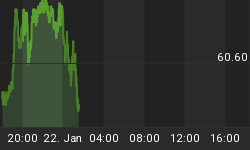These are uncharted waters, indeed. The shenanigans being foisted upon us by Washington are unprecedented at least since World War II, and probably ever. There is so much complexity, if not sheer trickery, going on that it becomes increasingly difficult to make any sense of what's happening, much less what the net effect is going to be.
Nevertheless, we must try.
As always, the first line of inquiry should be directed at the data, for the raw numbers tell us things that our politicians will reveal only reluctantly, if at all.
Let's first take a look at what didn't happen: Casey Research Chief Economist Bud Conrad has been scrunching the numbers to distill the bigger picture. Over the past four months, American banks have received massive amounts of bailout money, ostensibly to unfreeze the credit market and enable the banks to lend money again. That it didn't work is obvious from a couple of charts. Here's Bud's first chart.

Note that banks' cash assets rose by over a half-trillion dollars in just two and a half months. That's primarily the money (ours) that was handed over to them via the Federal Reserve. Did it go to a socially useful purpose? Mmmm... no. In actuality, we got scammed.
Here's how the scam operated: the Treasury borrowed our dollars via the sale of Treasury notes and deposited the cash at the Fed. The Fed used the money to relieve banks of their most toxic liabilities. But instead of lending it, the banks simply bought more Treasuries, thereby polishing up their balance sheets. This is made starkly evident by Bud's second chart, where you can see that cash was being hoarded even as lending declined.

The net result of this asset shuffling is that the Treasury (that's us) incurred more debt, the Fed absorbed all manner of toxic waste for which it may not get 10 cents on the dollar, and the banks wound up with many more bucks and much less junk, leaving them sitting pretty and chuckling all the way to... well, to the bank.
These were not small-potatoes moves, either. Check out Chart 3 below.

That bears repeating. The Treasury Department, on our behalf, nicked us for a cool trillion in three months. Never been done before.
And remember, over the same period, the Fed was bloating its balance sheet with financial garbage to the same trillion-dollar tune. Chart 4 shows the path of the reverse meteor.

As badly as it's behaved at times, the Fed hasn't done anything remotely like this in all its checkered 95-year history.
What's our point? Simply this: delicate financial balances are quickly falling into imbalance. Responses of gargantuan size have merely served to keep the system from collapsing and have barely begun to improve it. Thus, the situation is not yet stabilized. There will be new surprise problems, and bigger responses, for the foreseeable future. Of that we can be certain. And collectively, all the government's responses will inevitably have a negative effect on the value of the U.S. dollar.
With all these momentous forces at play, it's understandable that you would feel small and powerless. Obviously, you can't fight City Hall. But are there ways to play along with it? Is it possible to survive, and even prosper, while the economy heads for hell in a handbasket?
Yes... but you must look behind the headlines, learn to follow locked-in trends, and develop the foresight to invest counter to what the herd may be doing. The Casey Report brings you opportunities to accomplish just that.
In these times of crisis and extremely volatile markets, the trend can truly be your friend... if you recognize it in time to profit while the investing masses are still oblivious. Month after month, The Casey Report scrutinizes and analyzes emerging trends - a strategy that has been providing our subscribers with double- and triple-digit returns. Learn more here.
















